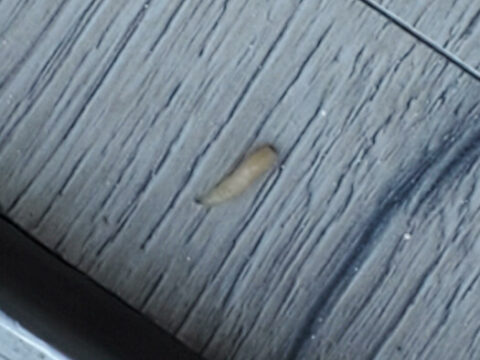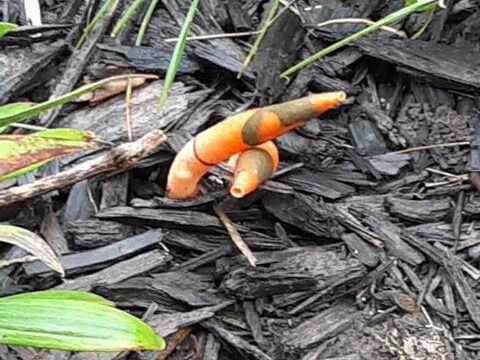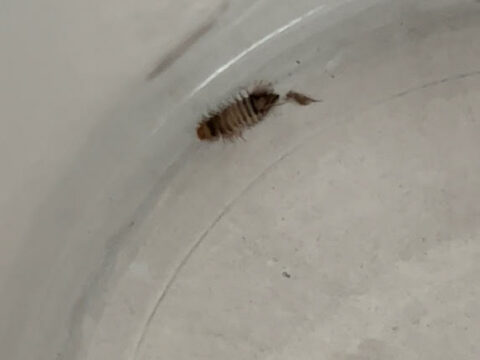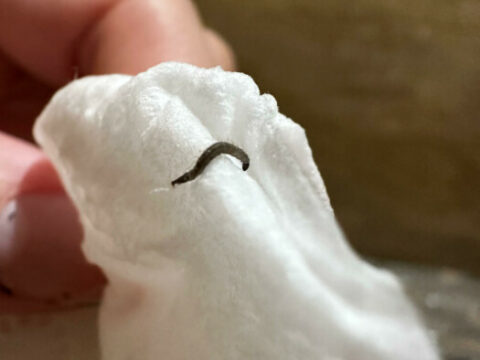Category: Worms Facts
Do Worms Have Feet?
“Do worms have feet?” asks Max in his submission. He does not include any photos, or any more context behind his question, but we will do our best to answer it nonetheless. The short answer is ‘no’. But if we take this a step further and ask why worms do not have feet, we get to the root of what worms really are to begin with. It would probably take studying the evolutionary history of worms to fully understand where this creature came from and to explain its footless state. Funnily enough, “a fossilized worm found” only a few years ago had scientists speculating that this creature may have been “key to the evolution of much of the animal kingdom”. So maybe we were all footless, legless worms at some point in time.
Long Worm with Antennae is a Centipede
“I found this worm on the hardwood floor”, writes Kelly in her submission regarding the long, thin worm-like creature pictured below. “We have a small Maltese so we were freaking out as it might be a simple earthworm or a parasite that came out of my dog! I checked my dog’s stool but didn’t see any signs of worms. The length was about 4+ inches. Thank you so much for your help!” Firstly, we want to thank Kelly ourselves for the photo and ample context. These factors always help us identify the worms we are asked about. And with that said, we think Kelly found a centipede.
Crumbly, Gray Matter from Tray Could be Mold or Just Debris
“I was wondering if you could help to determine what this stuff in the photo is that I found while cleaning a small tray I had on my bureau”, writes Sandra in her submission regarding the gray matter pictured below. “I just turned it over and this stuff came out. The tray is basket weaved and I had no idea the stuff was even there! I don’t know if it is eggs (although I have not seen any bugs) or what it could be but I tried looking for it online without success. I was hoping you could help me out with this and maybe what I should do? Thank you.”
Translucent Worms with Squiggly Red Insides Under Plant Pots are Sludge Worms
“I found these worms under my plant pots in the balcony garden”, writes this reader in his submission regarding the clear worm with red entrails pictured below. “They are hair-thin and they move in water at a good speed with snake-like movement. When I took a picture and zoomed in I found they have dots at one end of the body — the tail end I would assume. They look really frail, thread-like alarmist hair like. Three-to-five centimeters (1.2-2-inches) long and there’s quite a few of them in wet places under plant pots, fallen leaf debris, etc, after two days of rain. I wanna know if these are parasitic. And how to kill these without killing my plants. I’m from Maldives.”
Grayish-green Worm with Big Eye Spots is an Elephant Hawk Moth Caterpillar
“Is this an elephant hawk moth caterpillar?” asks Julia in her submission regarding the gray-green creature pictured below; it has a pattern of dots and circles on its back, as well as two big eye spots on its head. “I live in southwest Florida, right on the water. My daughter and I found this guy outside on the hot pavement, in quite a hurry. So we picked him up and placed him in the shade under a tree. I have looked and looked and can’t find any sightings of them anywhere near South FL. But he sure did have an elephant snout and the same markings. Is this guy really lost, or am I misidentifying? PS. Thanks for all you do! I’ve submitted questions several times. Even when you couldn’t directly help, your suggestions did.”
Clear Worm with Black Markings in Sink is a Drain Fly Larva
“What is this?” asks Jennifer in her submission regarding the semi-translucent worm with black markings pictured below. “I found this in my bathroom sink while brushing my teeth. It was wriggling near the sink drain. The picture is magnified several times.” We think Jennifer has found herself a drain fly larva, and it is quite incredible that she captured it in such detail, especially considering the photo is magnified. These guys are really tiny, and to the naked eye they just look like little black worms, so we commend Jennifer on the excellent photo! Neither drain fly larvae or the mature flies are harmful to humans, though they can prove to be quite the nuisance.
White Worm-looking Creatures in New Home are Blow Fly Larvae
“I woke up this morning, granted the second day of a new home and all over the living room floor there were little whitish, worm-looking things”, writes this reader in her submission regarding the organisms pictured below. “What are they? Where did they come from? And how do I get rid of them?” Our reader asks all the right questions, and to answer her first one, we think these are blow fly larvae. ‘Blow fly’ as a term refers generally to a large group of flies (known as an order) called Diptera. The adult flies are characterized by their glossy, metallic bodies, which are typically green, blue, or black in color.
Winged-bug Found in the Seam of Pants Could be a Fly or Wasp
“What kind of bug is this that I found in the seam of my pants?” asks Shanan in her submission regarding the six-legged, winged bug pictured below. “Thank you for your time.” Right away, we will have to state that since we specialize in identifying worm-like organisms, this is a bit outside of our area of expertise, and for that reason we cannot promise an accurate or confident identification. The best we can do is provide an educated guess. On top of that, the photos she sent in (the best of which we included below) were pretty blurry, which makes it even harder to arrive at an identification.
Skinny Light Brown Worm Appearing Next to Dead Spider is a Horsehair Worm
“Yesterday my kids caught a Hentz Orb-weaver in a small mason jar. I was going to set it free but I completely forgot about the spider and it was left in the sealed jar on my back porch and when I woke up I noticed the spider was dead but there was also a long skinny light brown worm like creature inside the jar next to the dead spider”, writes Kelsey in his submission regarding the worm pictured below. “I’m completely baffled because this worm was not in the jar last night and the Mason jar has a sealed aluminum lid so I can’t imagine anything getting through that. How did the worm get in the jar? Is it some kind of parasitic worm? Can orb weaver spiders carry parasitic worms? I am a little freaked out and I really want to know how and why this is possible. Please help! Oh and the worm is very much alive by the way.”
Velvety, Black, Worm-like Creatures in Apartment are Soldier Beetle Larvae
“I keep finding this worm around my apartment”, writes Alyssa in her submission regarding the segmented, velvety black, worm-like critter pictured below. “It first started by finding them by the front door then I found one in the kitchen one day, one in the living room and now two by/in my bedroom. The living room and bedroom are carpeted, the kitchen is not and neither is by the front door. They are about an inch in length and I usually find them curled up in a circle. I am a pretty clean person and clean once a week so I’m unsure why I’ve been finding these for the past week or so. I’d like to get rid of them for good but am not sure what they are! Help!”
Tubular, Orange ‘Worms’ are Actually Mushrooms
“At least, I think they are worms”, writes Jay in his submission regarding the tubular, orange objects pictured below. “They are in my garden, and clearly invertebrate. I’m in south-central Wisconsin, north of Madison by about 1/2 hour drive.” We have certainly never seen worms that look like these. At first sight, we thought of carrots, albeit hollow carrots. But these are clearly not carrots. That said, they are also not worms. They are actually a species of fungus called Mutinus elegans. These guys have many nicknames, including elegant stinkhorn, dog stinkhorn, headless stinkhorn, and much more.
Thin White Worms Floating in the Air Infest Woman’s Home
“My home is infested inside and out with thin white worms that appear to be accompanied by or some stage of a thin black worm”, writes Shari in her submission regarding the worm pictured below. “They scatter through the air with the slightest disturbance. I tried spraying them down with bleach attached to water hoses, but they just end up floating in the air and landing on me. Pest control has been no help in identifying. I live in Sarasota, Florida. My house is old, built in 1959 and had a major plumbing issue. Cast iron pipes broke underground and the entire plumbing clogged up. It was so bad water was coming out of the vent pipe on the roof. I’m wondering if this worm issue is related to the plumbing. Especially since the pipes broke underground.”
Worm with Antennae is a Millipede
“What kind of worm-like thing is this?” asks Evey in her submission regarding the segmented creature pictured below. “It has antennae and no legs. I found it burrowing in my ear.” To start with, we want to express our sympathy to Evey: it must be an unnerving experience to have any kind of creature burrowing into one’s ear. Now, given that this creature was found on/in Evey, we cannot provide an identification with 100% certainty or accuracy, because there is a chance that the discovery of this organism has medical implications. So, what we can do is direct Evey to some resources were she to grow concerned for her health as a result of finding this creature, and we can also provide an identification that should only be considered if a medical professional does not identify any medical issues (and does identify the worm-like creature as a threat) or if Evey is not concerned for her health as a result of this discovery.
Brown Striped Worms in Children’s Bedroom are Carpet Beetle Larvae
“What is this worm?” asks Billie in her submission regarding the brown-striped creature pictured below. “I found them on my children’s bedroom floor. We thought we had powderpost beetle infestation because we have small holes in some of our new hardwood floors. Maybe these bugs are unrelated? I found three at 6:30 in the morning after turning on the lights. The largest is probably less than 1/4 inch long.” We can tell Billie straight away that this is not a powderpost beetle or a powderpost beetle larva (which are white in color with a small black spot on its head), but is a carpet beetle larva. Billie may have heard of carpet beetles before: they are a notorious pest that do not feed on hardwood floors, but the rugs and carpets we put on top of them.
Long Gray Worm with Black Stripe is a New Guinea Flatworm
“What is this?” asks Cyndi in her submission regarding the long, black worm with a gray striped down its back pictured below. “It’s fascinating! I found it crawling on my window and along the window sill. It lifts its head moving forward. It almost appears to have eyes. It only moves forward (front is left to right). I appreciate the help!” Based on the fantastic photo Cyndi sent us, we think she has found a New Guinea flatworm. As their name suggests, this species of flatworm is endemic to New Guinea (the island off the coast of Australia), and is considered an invasive species in other countries. Besides concerns about how their presence will disrupt the biodiversity in the habitats they are introduced to, New Guinea flatworms do not pose much of a threat to humans, despite popular anti-flatworm rhetoric.
White Worms with Dark Heads in Horse’s Water Bucket May be Larvae
“I found these small, white worms in my horse’s water bucket in the barn”, writes Jennifer about the organisms pictured below. “I have seen them hanging from a thin thread they weave in his stall before. I am trying to identify them to make sure they aren’t toxic to him if he did ingest them. Thank you in advance.” First things first, we have to make clear that, given Jennifer’s concern for her horse’s health, any suggestions we make as to the identity of these worms should only be considered in light of these organisms being deemed non-threatening to the horse by a veterinarian. Since we are not medical professionals, we are neither qualified nor legally able to identify parasites or other organisms that directly impact the health of humans or pets, as doing so is tantamount to diagnosing their medical issue. So, we recommend that Jennifer asks a vet to check her horse and inspect the worms to see if they are a threat.
Toilet Full of Drain Fly Larvae After Weeks Away From Home
“We found these worms in one of our toilets after returning thirteen days later”, writes Jerry in his submission regarding the many, tiny, black, worm-like creatures pictured below. “No one used this toilet while we were gone. This toilet is on the second floor.” Considering the worms’ appearance and the context in which Jerry found them, we think he has found drain fly larvae. Also known as moth flies due to their stout, furry bodies which resemble moths more than the common house fly, drain flies are notorious bathroom pests. They are not pests so far as doing any real damage to the items in one’s home, but infestations of them can be hard to tackle and the flies can thereby become a real nuisance.
Black Worm in Bathroom is a Drain Fly Larva
“I found this in my bathroom and don’t know what it is”, writes Dainé in her submission regarding the bristly, black worm pictured below. “Could you please help me?” We are, of course, happy to help Dainé identify this creature. Although she does not provide much context, the little that we are provided, coupled with the fantastic photo, is enough for us to identify this organism, which is a drain fly larva. Otherwise known as moth flies, drain flies are commonly considered pests, though we would argue they really are not: they do not damage anything in the home, and they pose no real health threat other than potentially causing asthmatic reactions if an infestation of them is left for too long. Drain flies are attracted to bathrooms which have been left uncleaned or unused for a long time, laying its eggs on the organic film that forms in the lip of drains.
Five Black Worms in Home Could be Cutworms
“What are these?” asks Erin in her submission regarding the black, worm-like critter pictured below. “I found about five in my house.” She does not include any more context, and the photo is unfortunately of a low resolution, meaning the details get blurry when you try to zoom in on the little guy. For that reason, we will only be able to provide an educated guess as to what this is, rather than an accurate and confident identification. In any case, we think this is a larva of some kind, possibly a beetle larva.
White Segmented Worms are Clothes Moth Caterpillars
“What is this?” is all Kelly Jo writes about the segmented, white worm-like critters pictured below. It looks to us like the creatures are on a bed post, but that is mere speculation based on the little we can make out from the photo. Without more context, it will not be possible for us to give an exact identification, because the physical characteristics of this creature are so commonplace among worm-like creatures that it could be any number of things. With that said, we do think it is some type of insect larva (given the brown head and segmented body), and we will list some of the most likely creatures it could be, provided Kelly Jo found the creature in her home.























